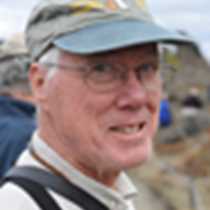Ideal Cove and Petersburg, Southeast Alaska
A soft morning mist engulfed us as the National Geographic Sea Lion moved south through Chatham Strait and into Frederick Sound. This is, after all, a temperate rain forest, and rain is part of the experience. Rain gives the land its character and its life. Our walks this morning took us along a boardwalk trail through Old Growth Forest at Ideal Cove, on Mitkof Island. Moss, lichens, ferns, and small flowering plants covered the forest floor in a profusion of green, even extending up the trunks and onto the branches of trees. Forest giants of Sitka spruce and western hemlock towered far above us. Between the bookends of the forest floor and canopy top were multiple layers of green: shrubs, saplings, and arboreal mosses and lichens. Few forests, any place on earth, can match the mass of green that comprises the Old Growth Temperate Rainforest. Even the old trees have their place in the economy of the forest. When a dead tree falls it creates a light gap in the forest, and new growth seizes the opportunity. The fallen giants are quickly colonized by mosses that trap seeds and become nurse logs for the next generation. Alongside us, a stream descended; the stream brings new nutrients to the forest in the bodies of salmon returning from the sea. The sea and the forest are inextricably connected. The ocean moderates the climate. Water evaporated from the ocean falls on land, bringing life, and then returns to sea. For a moment, we stood quietly, listening to the stream and feeling the soft, life-giving mist on our faces.
Over lunch, we moved to the nearby town of Petersburg, where harvesting the bounty of the sea dominates life and the economy. As the ship boarded a supply of salmon, halibut and a feast of Dungeness crab for our dinner this evening, we explored Petersburg. Some walked on the dock to look at fishing vessels and think about the management of this valuable resource. It is a challenging task, but hopefully Alaskans have learned enough from the mistakes of other fisheries to use our resources sustainably.
A short Zodiac ride across Wrangell Narrows took some of us to Kupreanof Island for a walk up another boardwalk through the forest to reach a muskeg bog. We passed evidence of hand-logging in the forest over a century ago, before chainsaws and clearcuts came to the forest. A muskeg is a bog with scattered, stunted trees. The environment is caused by a perched water table that causes water to saturate the soil, inhibiting decomposition and causing a severe shortage of the nutrients needed for growth. Here we found abundant sphagnum mosses, low- and slow-growing bog plants, and insectivorous sundews that capture their prey on sticky glands. The number of dead trees in the muskeg indicates that this habitat is growing in Southeast Alaska. Perhaps in 1,000 years it will be a much more frequent habitat type. Keep tuned.




